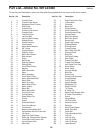
26
Conditioning Guidelines
The following nine steps for designing your exercise
program were developed by exercise physiologists.
The actual exercise you perform is only a part of a
safe and effective training program. There are many
other aspects to developing a life-long commitment to
physical fitness.
Consult your physician before beginning
any exercise program.
A medical examination or consultation with your
physician is essential.
Establish personal fitness goals.
Set attainable, realistic goals. Reward yourself
when you meet those goals. Remember, your
goals should act as a guide for your workout
program.
D
etermine your target heart rate.
Y
our
t
arget heart rate
(
THR), is the rate at which
you would like your heart to work during aerobic
exercise. It is expressed as a percentage of your
maximum heart rate
(MHR). MHR is the maxi-
mum number of times that your heart can pump
during one minute. To determine your approxi-
mate MHR, subtract your age (in years) from 220.
This is only an estimation of your MHR—only clin-
ical stress testing can provide an actual MHR
reading.
Once you have determined your MHR, you can
establish your target heart rate zone. Beginning
exercisers may wish to start at 60 to 70 percent of
their MHR. This level is called the
Health
level.
Exercise at 70 to 85 percent of your MHR for the
optimal training, aerobic, or cardiovascular level—
the
Fitness
level. Advanced exercisers, or those
wishing to do sports, athletic conditioning, or inter-
val training workouts should exercise at 80 to 85
percent of the MHR for short periods of time. The
chart below shows Target Heart Rate Zones for
Health, Fitness, and Advanced exercisers.
Be sure to check your heart rate at least twice
during an aerobic conditioning session. First,
check your heart rate five minutes into your work-
out to be sure that you are at the proper intensity.
Then, check it again near the end of your workout
to verify that you have maintained your target
heart rate for the recommended period of time.
3
2
1
FACTORS IN A SENSIBLE DIET
• Choose high-fiber, low-fat, and low-in-sugar
foods: fruits, vegetables, and whole grains.
• Eat at least five servings of fruits and
vegetables each day.
• Cut back on red meat consumption; eat lean
meat, white meat, and fish.
• Choose healthy snacks; bring healthy foods
with you to work or in the car.
• Eat regular meals or mini-meals. Control your
portion size—don't binge or overeat. Eat
slowly.
• Reduce fast food and pre-packaged meals.
• Pay attention to fat content and calories.
• Limit alcoholic beverages and caffeine.
• Drink at least eight to ten glasses of water a
day.
EXERCISE STEPS
200
180
160
140
120
100
80
25 30 35 40 45 50 55 60 65 70
Pulse
Age
Health Fitness Advanced
TARGET HEART RATE ZONES
Beginner,
low-intensity
+
long duration
=
fat burning
Optimal train-
ing, aerobic or
cardiovascular
Sports, athletic
conditioning,
interval training


















